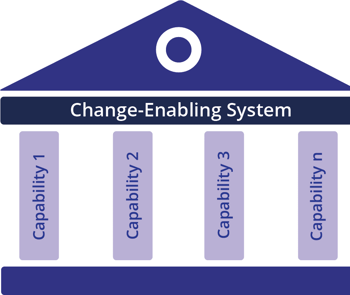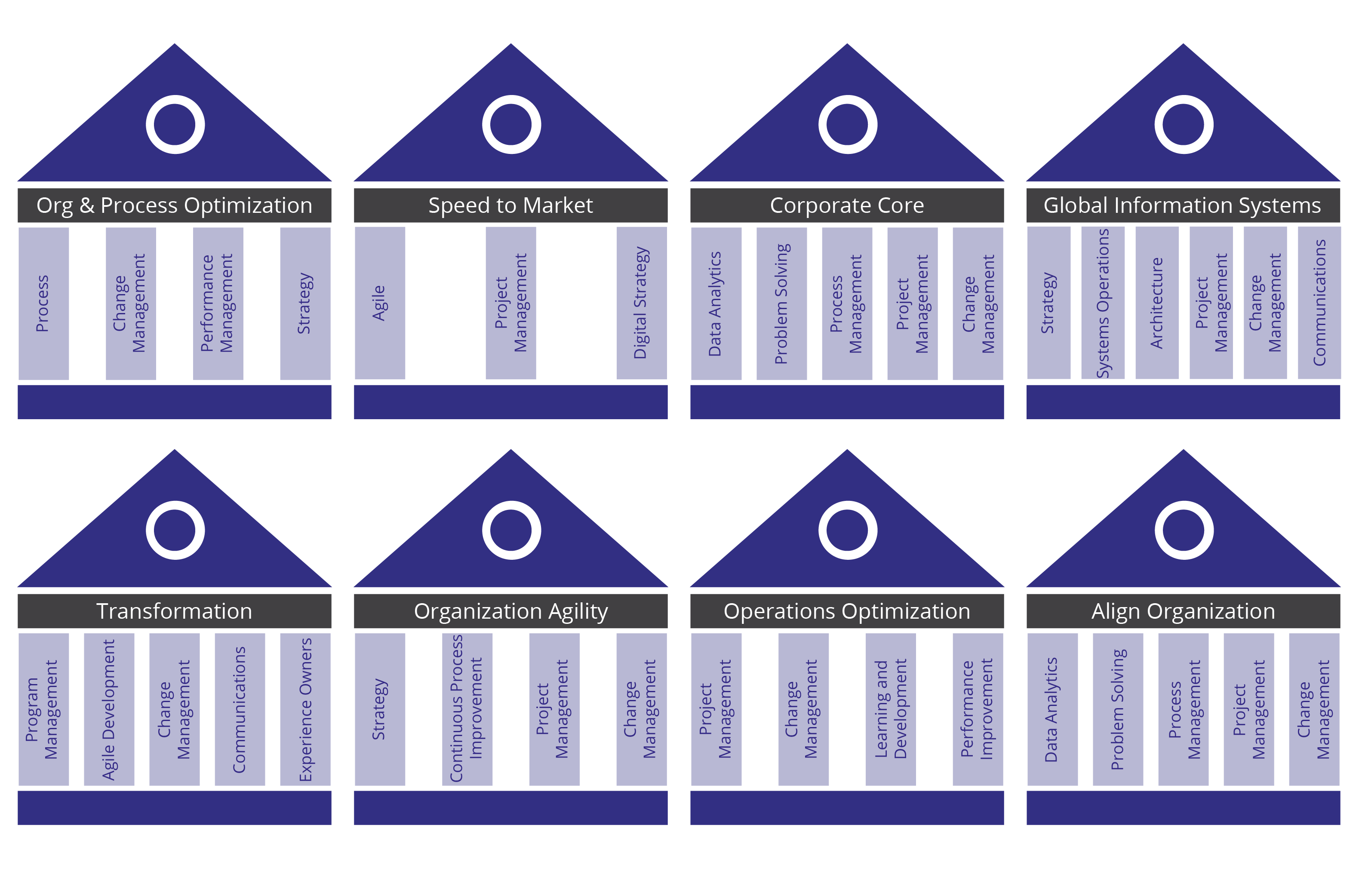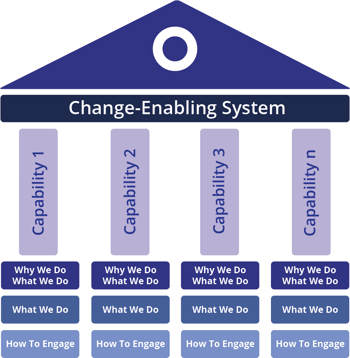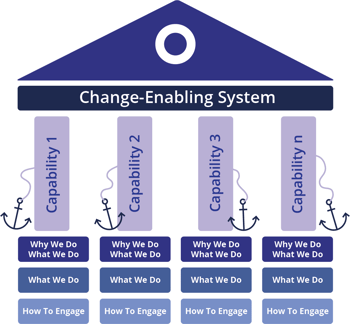Harnessing the Power of Change-Enabling Systems

5 Mins
Updated: June 6, 2024
Published: January 10, 2019

To face today’s increasing velocity of change, organizations are working to build change capabilities—the “muscle” in specific disciplines that support change execution. The disciplines include project management, continuous improvement, Agile, organization development, and change management. Leading organizations have taken the next step and moved these capabilities under an umbrella focused on change implementation—what we call a “change-enabling system” here.
This article explores the emergence of change-enabling systems, their challenges and a framework for harnessing the power of this crucial development.
To address today’s state of change, organizations are establishing change-enabling systems
to house and grow key change capabilities. The challenge is ensuring that
these systems and capabilities are effectively driving change results.
Foundation and Definitions
To establish some alignment and shared understanding up front, we’ll define both Change-Enabling System and Change Capability.
- Change-Enabling System: A platform of several change capabilities intended to provide a coordinated solution supporting change efforts to increase change outcomes and probability of success. These change-enabling systems exist across a spectrum from formal to informal.
- Change Capability: A particular discipline or body of knowledge/effort intended to address a particular facet of organizational performance and Specific capabilities have developed and grown in response to the challenges of the time. Some of these have decades of history – such as project management and Organization Development – while others have only emerged in recent years – such as Agile and data analytics.

| Example Contemporary Capabilities: | ||
|
|
|
Are you implementing an ERP system or other enterprise technology?
Prosci Advisory Services can help ensure your success—and start building change capabilities in your organization.
Learn More
The discipline mix in a particular change-enabling system is based on the unique needs, challenges and opportunities of the organization. For example, a high-volume manufacturer might have a heightened emphasis on quality and continuous improvement, while a software solution provider might focus on iterative development and knowledge management, while a hospital system might focus on talent recruitment and development.
The external triggers and internal performance drivers of your organization dictate
the particular capabilities that comprise your change-enabling system.
Examples
I’ve been surprised by how many of these emergent “change-enabling systems” I have come across in the past year in my role as Chief Innovation Officer at Prosci. Whether in executive councils, at conferences or with specific clients, I’m seeing more and more of these systems being stood up. Below are just a handful of examples from my recent interactions:

Value
Change-enabling systems, if implemented and harnessed effectively, bring tremendous value to the organization in terms of change execution, innovation and preparation for the future.
Change Execution
The issues and opportunities that organizations face today are multi-faceted in nature. These opportunities and the resulting responses/initiatives cannot be effective if they are silo-ed or singular; effective responses must also be multi-faceted. An effectively engaged change-enabling system brings the right mix of capabilities and right tools at the right time to deliver the best outcomes.
"We cannot solve our problems with the same thinking we used when we created them."
—Albert Einstein
Innovation
Fran Johansson wrote the book The Medici Effect chronicling the emergence of the Renaissance and the cross-pollination that resulted. His work focused on the innovation that was sparked in the area from the intersection of various disciplines and thinkers. In today’s organizational change space, change-enabling systems provide the platform to foster and spark cross-pollination, innovation and extraordinary new ideas.
"When you step into an intersection of fields, disciplines, or cultures, you can combine existing concepts into a large number of extraordinary new ideas."
—Frans Johansson
Preparation for the Future
In addition to the need for execution today and innovation through interaction of these disciplines, building coordinated “change muscle” with capabilities and a change-enabling system will be essential going forward. Establishing, nurturing and harnessing the ability to effectively change will be paramount in an increasingly changing and competitive world.
Challenges
Three major challenges to these change-enabling systems include:
1. Confusion among the capabilities
Whether it is from lack of knowledge, pre-conceived notions or misperceptions, there can be confusion among the capabilities that limit the impact of the system.
“Project managers just check boxes.”
“OD has no connection to real results.”
“Change management is the soft, fuzzy stuff.”
“I don’t have any idea what they mean when they say Agile.”
These are just a few examples of what you might hear when confusion muddies the waters and inhibits improvement potential.
2. Siloed and non-collaborative
After decades working to de-silo operations, an interesting thing has happened in the change space. The capabilities used to drive change have been re-silo-ed. Without concerted effort, these capabilities do not come together to work in unison to drive more successful change. At one end, they are not collaborating, at the other end, they can become downright combative. This sub-optimizes the impact and outcome of establishing change muscle.
3. No vision of what the system should deliver
The capability building efforts were commissioned; the change-enabling system was chartered. But no one has stepped back to describe what the future state looks like. Often times, no leadership has been provided or accountability established. With a lack of vision of what the system can deliver, many find themselves in the predicament described by Yogi Berra, “If you don’t know where you are going, you might wind up someplace else.”
"Coming together is a beginning. Keeping together is progress. Working together is success."
—Henry Ford
Harnessing the Power
Despite these challenges, there are specific steps you, as an architect of the change-enabling system or practitioner working within a particular capability, can take to improve the effectiveness of the system and resulting change outcomes. Three tactics for harnessing the power of your change-enabling system:
- Common and shared understanding
- Anchors for integration
- Platform for collaboration
Common and Shared Understanding
How do you ensure that everyone is “reading from the same sheet of music” regarding change management or Agile or Organization Development or any of the capabilities that make up the system? Creating a common and shared understanding of the change-enabling system as a whole, and of each capability in particular,
is crucial for addressing confusion and priming the power to change. The clarity and alignment that results from a common and shared understanding is crucial. It ensures that the motivation, work and contribution of each capability are clear. Recently I’ve used a simple framework with clients for documenting and describing a particular capability to build a common and shared understanding:
- Why We Do What We Do – this focuses on the motivation and value of the capability
- What We Do – this focuses on the detailed work of the capability
- How To Engage Us – this focuses on how to connect with the capability

If each capability in the system can define and share these three elements, you work toward a common and shared understanding that sets the stage for integration and collaboration.
Anchors for Integration
How do you intentionally create “hooks” for the capabilities that make up an energized change-enabling system? How (and when) does a particular change effort “fasten” to each of the capabilities? Each capability has a unique focus and contribution that supports successful change, but without confirmed anchors for integration, there is no way to cross the silos and drive a unified front.
For change management (since it is the capability I work the most with), the anchors I’ve introduced revolve around two aspects: How much of the change outcomes depend on employee adoption and usage? 2) Who has to do their jobs differently and how? Any initiative can ask and answer these questions, which become the hooks for applying change management.
Each capability, based on its unique contribution, will have specific anchors that enable integration of the capabilities. Energizing a change-enabling systems requires these anchors.

Platform for Collaboration
How will the change-enabling system be led, energized and optimized? Some change-enabling systems are less formal, and rely even more heavily on collaboration through relationships. If a formal structure has been established, the foundation of the platform has been laid. But simply chartering or structuring the platform is not sufficient. The change-enabling system itself needs direction and guidance. It needs a vision, and its own “Why we do what we do, What we do, How to engage” to create shared understanding. It needs a sponsor. It needs a plan.
Conclusion
Organizational change is an exciting space right now. The pace, interconnectedness, complexity and importance of change are all increasing. And, over the past several decades in response, unique approaches have emerged specializing in specific contributions to improving organizations.
Standing up a change-enabling system is an important step toward providing multi-faceted solutions to today’s multi-faceted problems. But simply chartering the system is not enough. Specific steps must be taken to build a common and shared understanding, establish anchors for integration and energize the platform for collaboration.


